Related Research Articles
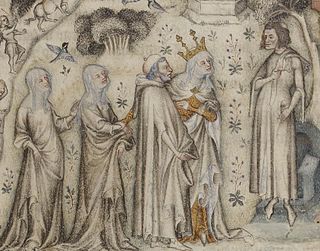
Guillaume de Machaut was a French composer and poet who was the central figure of the ars nova style in late medieval music. His dominance of the genre is such that modern musicologists use his death to separate the ars nova from the subsequent ars subtilior movement. Regarded as the most significant French composer and poet of the 14th century, he is often seen as the century's leading European composer.

The Mass is a form of sacred musical composition that sets the invariable portions of the Christian Eucharistic liturgy, known as the Mass.
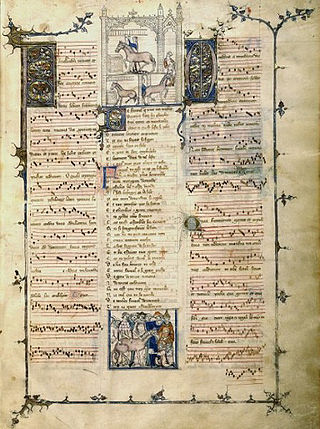
Ars nova refers to a musical style which flourished in the Kingdom of France and its surroundings during the Late Middle Ages. More particularly, it refers to the period between the preparation of the Roman de Fauvel (1310s) and the death of composer Guillaume de Machaut in 1377. The term is sometimes used more generally to refer to all European polyphonic music of the fourteenth century. For instance, the term "Italian ars nova" is sometimes used to denote the music of Francesco Landini and his compatriots, although Trecento music is the more common term for the contemporary 14th-century music in Italy. The "ars" in "ars nova" can be read as "technique", or "style". The term was first used in two musical treatises, titled Ars novae musicae by Johannes de Muris, and a collection of writings attributed to Philippe de Vitry often simply called "Ars nova" today. Musicologist Johannes Wolf first applied to the term as description of an entire era in 1904.
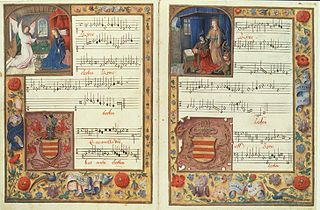
The Chigi codex is a music manuscript originating in Flanders. According to Herbert Kellman, it was created sometime between 1498 and 1503, probably at the behest of Philip I of Castile. It is currently housed in the Vatican Library under the call number Chigiana, C. VIII. 234.

The French Organ Mass is a type of Low Mass that came into use during the Baroque era. Essentially it is a Low Mass with organ music playing throughout: part of the so-called alternatim practice.
In Renaissance music, the cyclic mass was a musical setting of the Ordinary of the Roman Catholic Mass, in which each of the movements – Kyrie, Gloria, Credo, Sanctus, and Agnus Dei – shared a common musical theme, commonly a cantus firmus, thus making it a unified whole. The cyclic mass was the first multi-movement form in western music to be subject to a single organizing principle.

Missa brevis usually refers to a Mass composition that is short because part of the text of the Mass ordinary that is usually set to music in a full Mass is left out, or because its execution time is relatively short.

Messe de Nostre Dame is a polyphonic mass composed before 1365 by French poet and composer Guillaume de Machaut. Widely regarded as one of the masterpieces of medieval music and of all religious music, it is historically notable as the earliest complete setting of the Ordinary of the Mass attributable to a single composer.
The Toulouse Mass is a polyphonic 14th-century musical setting of the Mass found in a manuscript in the municipal library of Toulouse. It was not composed by a single individual, but is presumed to have been compiled and performed as a unit. The present location of Toulouse does not necessarily mean it was composed there.

The Missa de Beata Virgine is a musical setting of the Ordinary of the Mass, by Renaissance composer Josquin des Prez. Though formerly believed to have been a late composition on the basis of stylistic analysis, evidence from Burchard’s Diary proves that the mass was written sometime before September 23, 1497. It was the most popular of his masses in the 16th century.

The Barcelona Mass is a polyphonic mass written around 1360. Together with the Messe de Nostre Dame by Guillaume de Machaut and those of Toulouse, Tournai and the Sorbonne, it is one of the earliest preserved complete polyphonic musical settings of the Ordinary of the Mass. It is believed to belong to the repertoire of the Papal court at Avignon and is also linked to the chapel of King Martin I of Aragon.
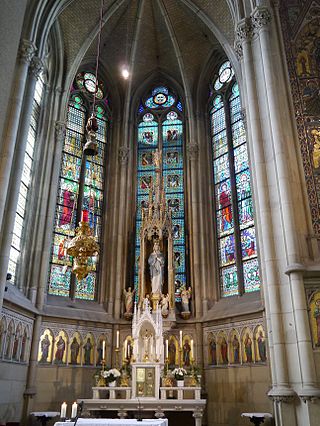
The Mass No. 2 in E minor, WAB 27 is a setting of the mass ordinary for eight-part mixed choir and fifteen wind instruments, that Anton Bruckner composed in 1866.
Ensemble Organum is a group performing early music, co-founded in 1982 by Marcel Pérès and based in France. Its members have changed, but have included at one time or another, Josep Cabré, Josep Benet, Gérard Lesne, Antoine Sicot, Malcolm Bothwell. They have often collaborated with Lycourgos Angelopoulos and are influenced by Orthodox music.
Most of Johann Sebastian Bach's extant church music in Latin—settings of the Mass ordinary and of the Magnificat canticle—dates from his Leipzig period (1723–50). Bach started to assimilate and expand compositions on a Latin text by other composers before his tenure as Thomaskantor in Leipzig, and he continued to do so after he had taken up that post. The text of some of these examples by other composers was a mixture of German and Latin: also Bach contributed a few works employing both languages in the same composition, for example his early Kyrie "Christe, du Lamm Gottes".
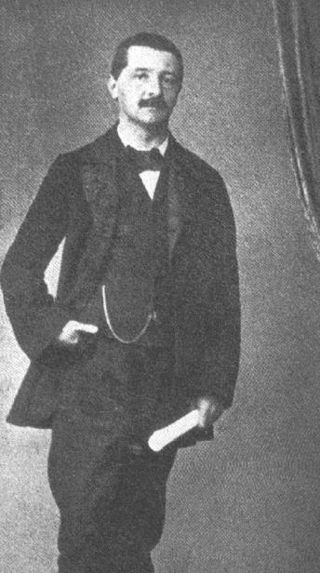
The Windhaager Messe, WAB 25, is a missa brevis composed by Anton Bruckner in 1842.

The Kronstorfer Messe, WAB 146, is a missa brevis composed by Anton Bruckner in 1843-1844.

The Messe für den Gründonnerstag, WAB 9, is a missa brevis composed by Anton Bruckner in 1844.
The Missa Di dadi, also known as the Dice Mass or Missa N'aray je jamais mieulx, is a musical setting of the Ordinary of the Mass by Franco-Flemish composer Josquin des Prez, probably dating from around 1480. It uses the chanson N'aray je jamais mieulx by Robert Morton as the source of its cantus firmus, and also contains unique visual and musical references to dice. The latter is thought to be a reference to the popularity of gambling in the court of the Sforza family at Milan, where Josquin wrote it.
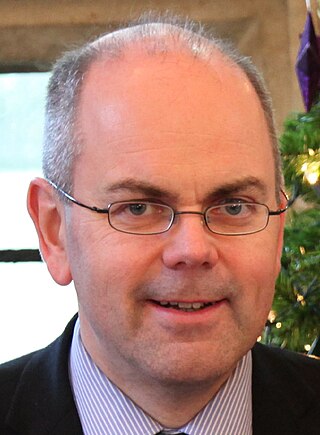
Messe in G is a mass in G major by the English composer Christopher Tambling. He composed it in 2013, scored for mixed choir and organ, optionally also with orchestra. The congregation is meant to participate, singing the theme of the Gloria as a refrain, and the theme of the Sanctus. The mass was first published in 2014.

Missa Providentiae is a Kyrie–Gloria Mass in D minor composed by Antonio Caldara, which around 1728 was expanded into a Missa tota by Jan Dismas Zelenka: this composer derived a Sanctus and Agnus Dei from Caldara's Kyrie and Gloria, and added a Credo, ZWV 31, of his own hand. Around 1738–1741, Johann Sebastian Bach made a copy of a Sanctus, BWV 239, which was based on the first section of the Gloria of Caldara's Kyrie–Gloria Mass.
References
- Richard H. Hoppin, Medieval Music. New York, W. W. Norton & Co., 1978.